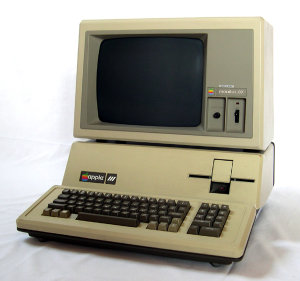Apple III
 |
|
| Release date | May 1980 |
|---|---|
| Introductory price | 4340 US$ - 7800 US$ (today $12615.10 - $22672.29) |
| Discontinued | April 1984 |
| Operating system | Apple SOS |
| CPU | Synertek 6502A @ 2 MHz |
| Memory | 128 KB RAM, expandable to 512 KB |
| Predecessor | Apple II |
| Successor | Apple III Plus |
The Apple III (often styled as apple ///) is a business-oriented personal computer produced and released by Apple Computer that was intended as the successor to the Apple II series, but was largely considered a failure in the market. Development work on the Apple III started in late 1978 under the guidance of Dr. Wendell Sander. It had the internal code name of "Sara", named after Sander's daughter. The machine was first announced and released on May 19, 1980, but due to serious stability issues that required a design overhaul and a recall of existing machines, it was formally reintroduced in the second half of 1981. Development stopped and the Apple III was discontinued on April 24, 1984, and its last successor—the III Plus, was dropped from the Apple product line in September 1985.
The Apple III could be viewed as an enhanced Apple II – then the newest heir to a line of 8-bit machines dating back to 1976. However, the Apple III was not part of the Apple II line, but rather a close cousin. The key features business users wanted in a personal computer were a true typewriter-style upper/lowercase keyboard (as opposed to the Apple II, which only supported uppercase letters) and 80-column display. In addition, the machine had to pass U.S. Federal Communications Commission (FCC) radio frequency interference (RFI) qualifications for business equipment. In 1981, International Business Machines (IBM) unveiled the IBM Personal Computer (IBM PC) – a completely new 16-bit design soon available in a wide range of inexpensive clones. The business market moved rapidly towards the PC DOS/MS-DOS platform, eventually pulling away from the Apple 8-bit computer line.
Despite numerous stability issues and a recall that included the first 14,000 units off the assembly line, Apple was eventually able to produce a reliable and dependable version of the machine. However, damage to the computer's reputation had already been done and it failed to do well commercially as a direct result. In the end, an estimated 65,000–75,000 Apple III computers were sold. The Apple III Plus brought this up to ~120,000. Apple co-founder Steve Wozniak stated that the primary reason for the Apple III's failure was that the system was designed by Apple's marketing department, unlike Apple's previous engineering-driven projects. The Apple III's failure led to Apple reevaluating their plan to phase out the Apple II, and eventual continuation of development of the older machine. As a result, later Apple II models incorporated some hardware, such as the Apple Scribe Printer, a thermal printer, and software technologies of the Apple III.
...
Wikipedia
